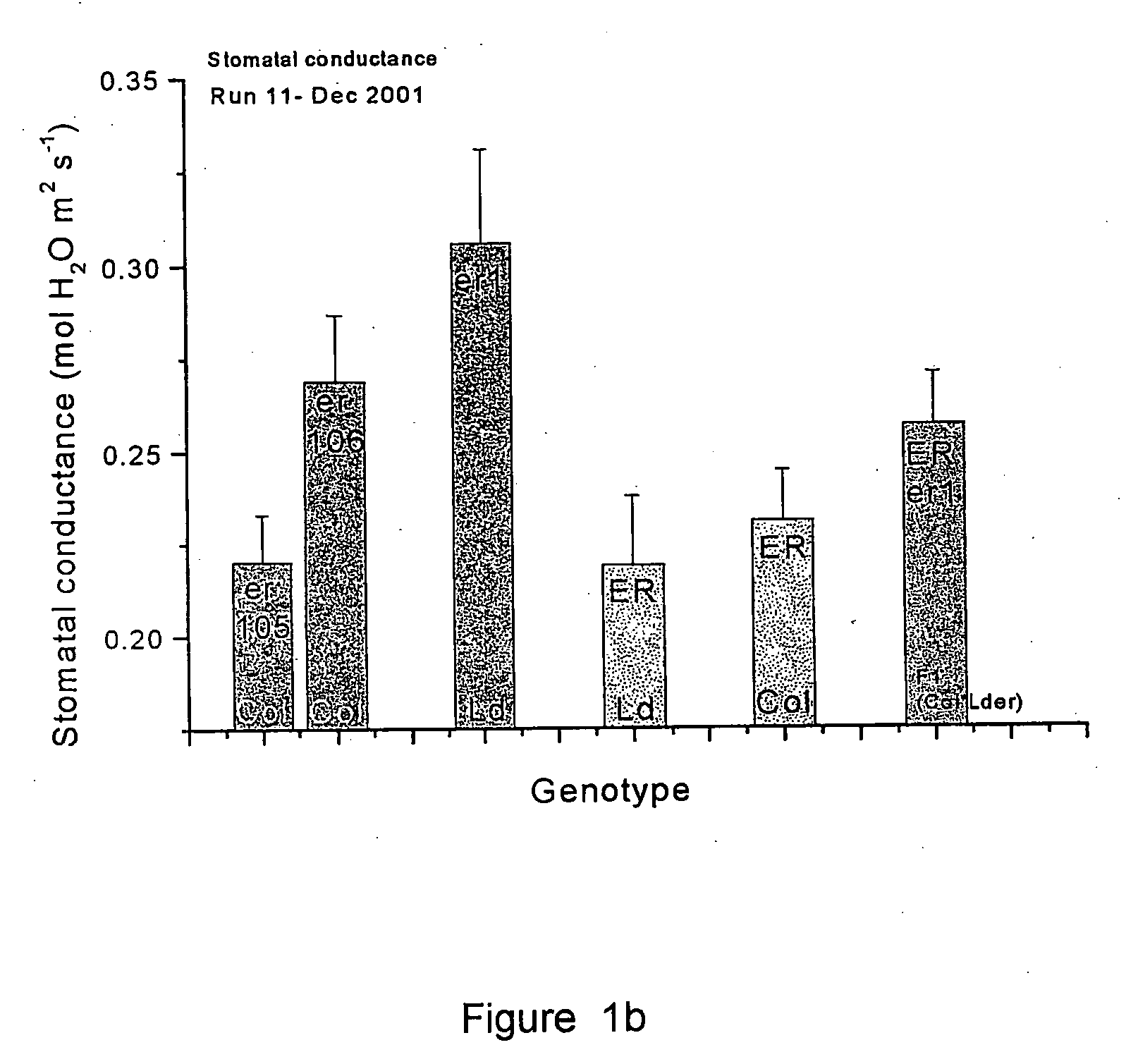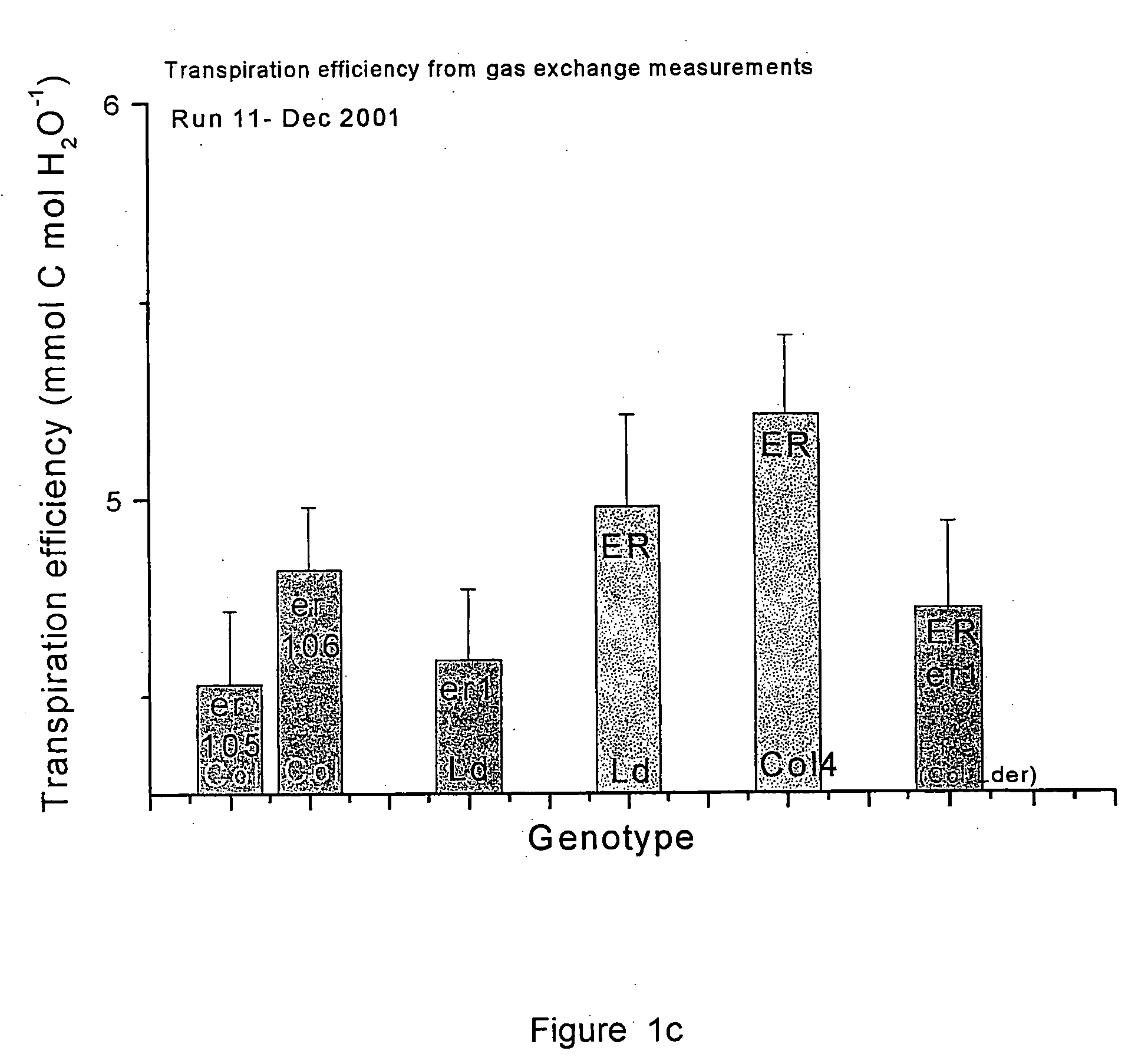Method of producing plants having enhanced transpiration efficiency and plants produced therefrom
a technology of transpiration efficiency and plant, applied in the field of plant breeding and the production of genetically engineered plants, can solve the problems of inefficient utilization of agricultural water, adverse effects on the supply of navigable water, potable water, water for industrial or recreational use, and the inability to achieve the procedure. the effect of enhancing transpiration efficiency
- Summary
- Abstract
- Description
- Claims
- Application Information
AI Technical Summary
Benefits of technology
Problems solved by technology
Method used
Image
Examples
example 1
12C / 13C Discrimination as a Marker for Screening Genetic Variation in Transpiration Efficiency
[0306] Experimental conditions and sampling procedures were established to allow the control of many factors, other than genetic, that influence transpiration efficiency at the level of individual leaves and plants. These factors fall into several categories: (a) characteristics of the seedling's micro-environment: temperature, light, humidity, boundary layer around the leaves, root growth conditions; (b) developmental and morphological effects that modify gas exchange and C metabolism and therefore carbon isotopic signature (eg age, stage, posture); and (c) seed effects.
[0307] We developed high resolution mass-spectrometer techniques for measuring C isotope ratios in whole tissues or carbon compounds such as soluble sugars—ie a measure of integrated transpiration efficiency over the plant's life or over a day, respectively, and also for measuring instantaneous transpiration efficiency du...
example 2
Natural Genetic Variation in Transpiration Efficiency in Arabidopsis thaliana
[0312]A. thaliana ecotypes were screened for leaf Δ under glasshouse conditions. There was a large spread of values (corresponding to approximately 30% genetic variation in transpiration efficiency). However, large environmental effects were noted. A few contrasted ecotypes were selected at the two extremes of the range of Δ values and compared under various conditions of irradiance (150 to 500 μE m−2s−1), light spectrum (Red / Far-Red ratios) and air humidity (60 to 90%) while roots were always well watered. The magnitude of genetic differences in transpiration efficiency was very much influenced by environmental conditions. This was in part due to variations among ecotypes in the dependence of photosynthesis on light and vapour pressure deficit. Genetic differences were maximal under a combination of high light and low humidity, in growth chambers.
[0313] The ecotypes Columbia (Col) and Landsberg erecta (L...
example 3
Identification of a Locus Associated with Transpiration Efficiency in A. thaliana
[0314] Quantitative Trait Loci (QTL) analysis of the Lister and Dean's (1993) Recombinant Inbred Lines (later referred to as RILs) was performed to identify and map a locus associated with carbon isotope discrimination (Δ). The RILs were from a cross between Col-4 and Ler-0. Our analysis showed the importance of genes around the ER locus on chr2, and a role for genes other than ERECTA in conferring transpiration efficiency on A. thaliana.
[0315] More particularly, 300 RI mapping lines between Col and Ler ecotypes, available at the Arabidopsis Stock Centre, were generated from a cross between the Arahidopsis ecotypes Columbia (Col4) and Landsberg erecta (Ler-0 carrying er1) (Lister and Dean, 1993), using Columbia as the male parent. A subset of 100 of these lines, chosen as the most densely and reliably mapped were used in the present analysis.
[0316] The seeds were multiplied in a glasshouse in an atte...
PUM
| Property | Measurement | Unit |
|---|---|---|
| Fraction | aaaaa | aaaaa |
| Molar density | aaaaa | aaaaa |
| Molar density | aaaaa | aaaaa |
Abstract
Description
Claims
Application Information
 Login to View More
Login to View More - R&D
- Intellectual Property
- Life Sciences
- Materials
- Tech Scout
- Unparalleled Data Quality
- Higher Quality Content
- 60% Fewer Hallucinations
Browse by: Latest US Patents, China's latest patents, Technical Efficacy Thesaurus, Application Domain, Technology Topic, Popular Technical Reports.
© 2025 PatSnap. All rights reserved.Legal|Privacy policy|Modern Slavery Act Transparency Statement|Sitemap|About US| Contact US: help@patsnap.com



